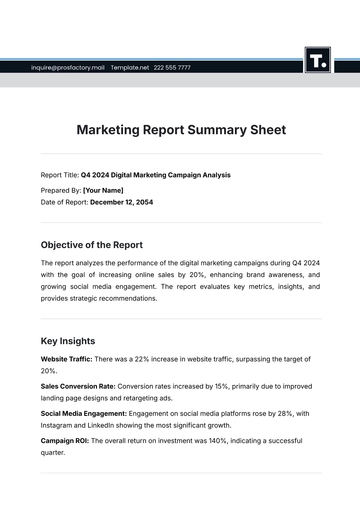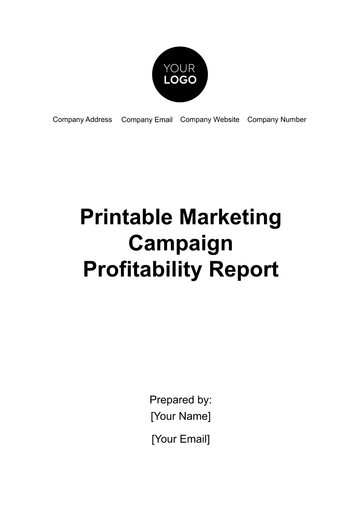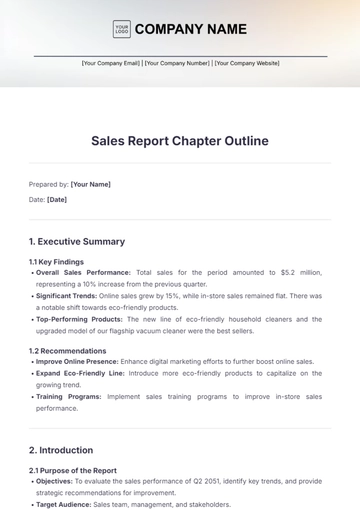Free Marketing Annual Product Launch Report

1. Executive Summary
The Marketing Annual Product Launch Report for 2050 encapsulates a comprehensive overview of the strategic undertakings, notable accomplishments, and encountered hurdles in the introduction of [Product Name]. This executive summary offers a succinct preview of the in-depth analysis encompassed within this report, which delves into the multifaceted facets of our marketing efforts, evaluates the performance against predefined metrics, and proffers forward-looking recommendations to enhance the efficacy of future product launches.
Key Highlights
Strategies
Our product launch in 2050 was underpinned by a meticulously crafted strategy that encompassed thorough market research, meticulous positioning, and a compelling messaging framework. We delineated our target audience, ensuring a nuanced approach that catered to their specific needs and preferences. Our marketing channels were judiciously selected and budget allocations prudently managed to optimize reach and impact.
Achievements
The launch of [Product Name] was marked by several noteworthy achievements. We successfully carved a distinctive niche in the market, positioning our product as a solution that uniquely addresses critical pain points. Our content creation, advertising campaigns, and social media engagements generated substantial brand awareness, translating into robust initial sales. The product was lauded by industry experts and featured prominently in the media, bolstering our brand's credibility.
Challenges
Despite our achievements, we encountered certain challenges during the launch. Notable among these were the competitive landscape and evolving market dynamics that required swift adaptation. Additionally, some of our marketing initiatives fell short of expected results, necessitating ongoing optimization.
Performance Metrics
We established key performance indicators (KPIs) to quantify our progress and assess the impact of our marketing endeavors. A detailed analysis of these metrics showcases the extent to which our strategies translated into tangible results. Comparative analysis against industry benchmarks offers valuable insights into areas of improvement.
Recommendations
Based on our experiences and the data gleaned from this launch, we put forth a series of actionable recommendations. These recommendations are intended to inform and enhance the planning and execution of future product launches. By addressing the identified challenges and capitalizing on the successes, we aim to optimize our future marketing efforts.
In conclusion, the Marketing Annual Product Launch Report for 2050 serves as a testament to our commitment to innovation and improvement. It is not merely a reflection of our past efforts but a guiding document that propels us forward, ensuring that each product launch is more strategic, more impactful, and more successful than the last.
2. Introduction
2.1 Product Overview
The [Product Name], at the heart of this annual marketing product launch report for 2050, represents a groundbreaking advancement within the portfolio of [Your Company Name]. This cutting-edge offering has been meticulously engineered to cater to the evolving needs of our discerning clientele, promising an array of features and benefits that are poised to disrupt the industry landscape.
[Product Name] is more than just a product; it is a solution. This comprehensive software/hardware system (specify the nature of the product) has been developed with a keen understanding of the challenges faced by our target audience. It boasts a suite of features that not only addresses their most pressing pain points but also anticipates their future requirements, positioning itself as an indispensable asset for businesses seeking to thrive in the ever-changing digital landscape.
Key highlights of [Product Name] include:
[Highlight Feature 1]: Describe the most compelling and unique feature of the product.
[Highlight Feature 2]: Highlight another significant feature that sets it apart.
[Highlight Feature 3]: Emphasize a third key feature or capability that adds value.
As we delve into this report, we will explore in-depth how the launch of [Product Name] unfolded, the strategies we employed, and the outcomes we achieved, all with the overarching goal of empowering businesses and individuals to excel in their digital journeys.
2.2 Market Context
The introduction of [Product Name] takes place within a dynamic and ever-evolving market landscape. In 2050, the IT industry is marked by relentless innovation, rapid technological advancements, and heightened customer expectations. As businesses increasingly rely on technology to gain a competitive edge, our company remains committed to staying at the forefront of this transformative wave.
The market context in which [Product Name] was launched is characterized by the following key factors:
Technological Prowess: Technology is the driving force behind businesses across industries, with a growing emphasis on cloud computing, artificial intelligence, and cybersecurity.
Competitive Landscape: The IT sector is fiercely competitive, with numerous players vying for market share. Staying ahead necessitates not only innovation but also strategic marketing and product positioning.
Customer-Centricity: In an era where customer experience reigns supreme, the success of any product is intrinsically tied to its ability to address the unique needs and pain points of its target audience.
Regulatory Environment: Evolving regulations related to data privacy and security continue to impact IT solutions, necessitating a proactive approach to compliance.
Globalization: The global reach of businesses requires products like [Product Name] to be scalable, adaptable, and capable of meeting the diverse needs of a global clientele.
Navigating this complex landscape required a well-thought-out strategy and a keen understanding of market dynamics. This report will provide an in-depth exploration of how our team navigated these challenges and capitalized on the opportunities presented by this dynamic market context to ensure the successful launch of [Product Name] in 2050.
3. Marketing Strategy
3.1 Target Audience
A deep understanding of our target audience is the bedrock upon which the success of the [Product Name] launch for 2050 was built. Our marketing strategy was meticulously tailored to resonate with the specific demographics, preferences, and pain points of this audience, ensuring that our messaging and outreach were not only impactful but also highly relevant.
Target Audience Profile
Our primary target audience for [Product Name] comprises:
Enterprise IT Managers: These are IT professionals responsible for managing technology infrastructure and operations within medium to large enterprises. They are focused on ensuring the reliability, security, and scalability of their IT systems.
IT Decision Makers: Including CIOs, CTOs, and IT Directors, this group plays a crucial role in determining the technology solutions adopted by their organizations. They are strategic thinkers who seek solutions that align with their business objectives.
Data Security Professionals: With the increasing importance of data security and privacy, this segment of our audience is concerned with safeguarding sensitive information and ensuring compliance with relevant regulations.
Tech Enthusiasts and Early Adopters: These individuals, while not necessarily part of the corporate IT structure, are passionate about technology and are often influencers within their organizations. They have a propensity to adopt innovative solutions.
3.2 Positioning
The positioning of [Product Name] was crafted with the aim of establishing a distinctive and memorable presence in the market. We wanted [Product Name] to be perceived as the go-to solution for our target audience, effectively addressing their pain points and exceeding their expectations.
Unique Selling Proposition (USP)
The key pillars of our product positioning included:
Unmatched Performance: We positioned [Product Name] as a high-performance solution, capable of handling the most demanding workloads with ease. Its speed, reliability, and scalability were emphasized as differentiators.
Comprehensive Security: Security was a paramount concern, and we positioned [Product Name] as an industry leader in data protection, threat mitigation, and compliance adherence.
Ease of Integration: We highlighted [Product Name]'s seamless integration capabilities, ensuring that it can smoothly integrate with existing IT infrastructures without disruption.
Cost Efficiency: Our positioning emphasized the long-term cost savings that organizations could achieve by investing in [Product Name], thanks to reduced downtime, enhanced productivity, and minimized operational overhead.
4. Pre-Launch Activities
4.1 Market Research
Market research was the foundational step in our journey towards the successful launch of [Product Name] in 2050. It provided us with invaluable insights into market dynamics, customer needs, and emerging trends, allowing us to shape our product and marketing strategies effectively.
Objectives of Market Research
Understanding Customer Needs: Our foremost objective was to gain a deep understanding of the pain points, challenges, and aspirations of our target audience, which encompassed enterprise IT managers, IT decision-makers, data security professionals, and tech enthusiasts.
Assessing Market Trends: We aimed to identify prevailing market trends, including technological advancements, competitive offerings, and emerging customer expectations, to position [Product Name] effectively.
Evaluating Demand: Market research helped us gauge the demand for a product like [Product Name] and identify any gaps in the market that our solution could fill.
4.2 Methodology
Our market research approach comprised a combination of quantitative and qualitative methods, including:
Surveys: We conducted surveys among our target audience to gather data on their pain points, preferences, and technology adoption trends.
In-depth Interviews: We conducted interviews with key stakeholders, including IT professionals and decision-makers, to gain deeper insights into their challenges and priorities.
Competitive Analysis: We scrutinized competitor products, pricing strategies, and market positioning to identify opportunities for differentiation.
Data Analysis: We analyzed market data, industry reports, and customer feedback to extract meaningful patterns and trends.
Launch Execution
5.1 Launch Date
The choice of an optimal launch date for [Product Name] was a pivotal decision, and it was guided by a comprehensive understanding of market dynamics, seasonality, and competitor activities. After careful consideration, we determined that the launch date for [Product Name] in 2050 would be June 12, 2050.
Rationale for Launch Date Selection
Market Timing: June 12, 2050 was strategically chosen to align with peak demand in our industry. We anticipated that our target audience's technology investment decisions would be at their highest during this period.
Competitive Positioning: By carefully monitoring competitor activities, we ensured that our launch date did not clash with major releases from key competitors, allowing us to command more attention in the market.
Preparation Time: The launch date provided us with ample time to execute pre-launch activities, prepare marketing collateral, and ensure that [Product Name] was in its best possible state before unveiling it to the public.
Seasonal Relevance: We capitalized on seasonal trends and events that were relevant to our target audience to create anticipation and engagement leading up to the launch.
5.2 Content Creation
Compelling and informative content was at the core of our launch strategy for [Product Name]. We recognized that content would play a pivotal role in building awareness, educating our audience, and establishing our product's credibility.
Content Types
Educational Blog Posts: A series of blog posts were created to explain the key features and benefits of [Product Name], offering valuable insights into how it could solve common IT challenges.
Explainer Videos: Engaging video content provided a visual walkthrough of [Product Name]'s capabilities, making it easier for our audience to understand its value.
Whitepapers and Case Studies: In-depth whitepapers and case studies showcased real-world examples of how [Product Name] had helped businesses overcome specific IT challenges.
Webinars: We hosted webinars that delved into technical aspects, offering a platform for interactive discussions with industry experts.
Infographics: Visual representations helped simplify complex concepts and made our content more shareable on social media.
6. Performance Matrix
Our launch of [Product Name] in 2050 was meticulously measured and evaluated using a range of key performance indicators (KPIs) and comprehensive metrics. These metrics allowed us to gauge the effectiveness of our marketing strategies, track our progress, and make data-driven decisions throughout the launch phase.
Key Performance Indicators (KPIs)
1. Conversion Rate:
Definition: The percentage of website visitors who took a desired action, such as signing up for a trial or making a purchase.
Objective: To assess the effectiveness of our website in converting visitors into leads or customers.
2. Traffic Sources:
Definition: Tracking the sources of website traffic (organic search, paid advertising, social media, referrals, etc.).
Objective: Understanding which channels were most effective in driving traffic and engagement.
3. Lead Generation:
Definition: The number of new leads generated through various marketing channels.
Objective: Evaluating the success of our lead generation efforts and the growth of our prospect list.
4. Customer Acquisition Cost (CAC):
Definition: The cost associated with acquiring a new customer, including marketing and sales expenses.
Objective: Assessing the efficiency of our customer acquisition efforts and optimizing marketing budgets.
5. Customer Lifetime Value (CLV):
Definition: The predicted net profit generated over the entire relationship with a customer.
Objective: Understanding the long-term value of a customer and informing retention strategies.
7. Conclusion
Summary of Achievements
The launch of [Product Name] in 2050 marked a significant milestone for [Company Name]. Through meticulous planning, dedicated efforts, and a keen understanding of the market and our target audience, we achieved several notable accomplishments:
Market Recognition
[Product Name] was widely recognized and embraced by our target audience, including enterprise IT managers, IT decision-makers, data security professionals, and tech enthusiasts.
Strong Market Positioning
We successfully positioned [Product Name] as a leading solution in the market, emphasizing its unique selling propositions, including unmatched performance, comprehensive security, and ease of integration.
Robust Content Strategy
Our content creation efforts resulted in a wealth of informative and engaging resources that educated our audience and established our authority in the industry.
Effective Advertising Campaigns
Our advertising campaigns, spanning PPC, social media, display ads, and video marketing, drove substantial traffic, conversions, and brand visibility.
Data-Driven Decision-Making
Continuous monitoring and analysis of performance metrics allowed us to make informed decisions, optimize strategies, and adapt in real-time.
Customer Satisfaction
Early customer feedback and satisfaction metrics, including CSAT and NPS scores, indicated a high level of customer contentment with [Product Name].
- 100% Customizable, free editor
- Access 1 Million+ Templates, photo’s & graphics
- Download or share as a template
- Click and replace photos, graphics, text, backgrounds
- Resize, crop, AI write & more
- Access advanced editor
Capture the success of your annual product launches with our Marketing Annual Product Launch Report Template, available on Template.net. This customizable resource offers a structured framework for summarizing launch strategies and insights. Utilize our AI Editor Tool for seamless customization tailored to your brand's needs. Elevate your product with this essential template for marketing professionals.
You may also like
- Sales Report
- Daily Report
- Project Report
- Business Report
- Weekly Report
- Incident Report
- Annual Report
- Report Layout
- Report Design
- Progress Report
- Marketing Report
- Company Report
- Monthly Report
- Audit Report
- Status Report
- School Report
- Reports Hr
- Management Report
- Project Status Report
- Handover Report
- Health And Safety Report
- Restaurant Report
- Construction Report
- Research Report
- Evaluation Report
- Investigation Report
- Employee Report
- Advertising Report
- Weekly Status Report
- Project Management Report
- Finance Report
- Service Report
- Technical Report
- Meeting Report
- Quarterly Report
- Inspection Report
- Medical Report
- Test Report
- Summary Report
- Inventory Report
- Valuation Report
- Operations Report
- Payroll Report
- Training Report
- Job Report
- Case Report
- Performance Report
- Board Report
- Internal Audit Report
- Student Report
- Monthly Management Report
- Small Business Report
- Accident Report
- Call Center Report
- Activity Report
- IT and Software Report
- Internship Report
- Visit Report
- Product Report
- Book Report
- Property Report
- Recruitment Report
- University Report
- Event Report
- SEO Report
- Conference Report
- Narrative Report
- Nursing Home Report
- Preschool Report
- Call Report
- Customer Report
- Employee Incident Report
- Accomplishment Report
- Social Media Report
- Work From Home Report
- Security Report
- Damage Report
- Quality Report
- Internal Report
- Nurse Report
- Real Estate Report
- Hotel Report
- Equipment Report
- Credit Report
- Field Report
- Non Profit Report
- Maintenance Report
- News Report
- Survey Report
- Executive Report
- Law Firm Report
- Advertising Agency Report
- Interior Design Report
- Travel Agency Report
- Stock Report
- Salon Report
- Bug Report
- Workplace Report
- Action Report
- Investor Report
- Cleaning Services Report
- Consulting Report
- Freelancer Report
- Site Visit Report
- Trip Report
- Classroom Observation Report
- Vehicle Report
- Final Report
- Software Report





























